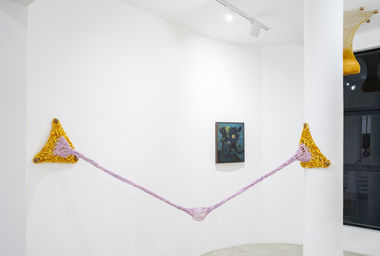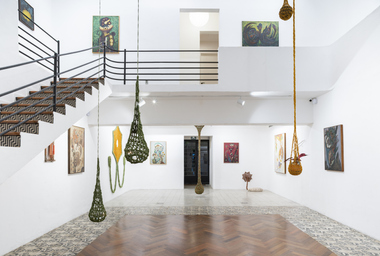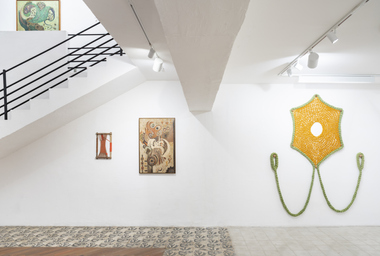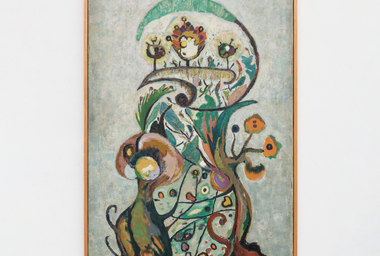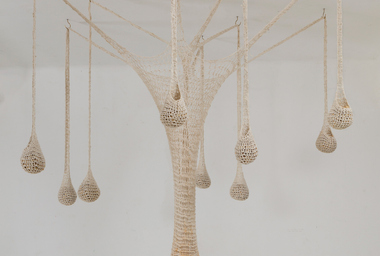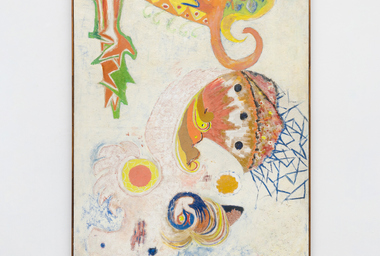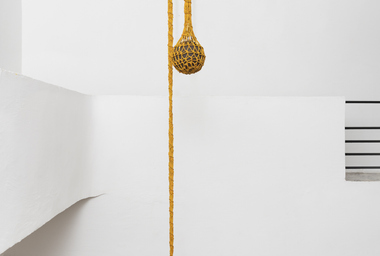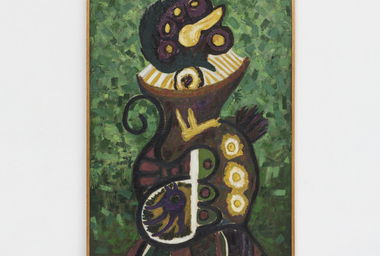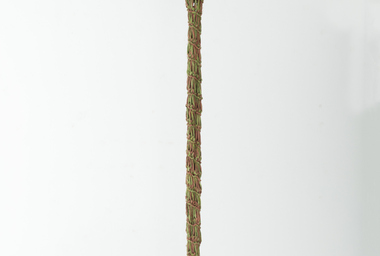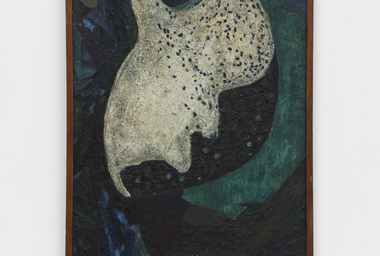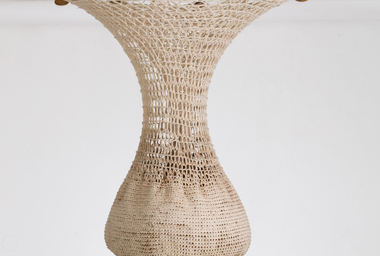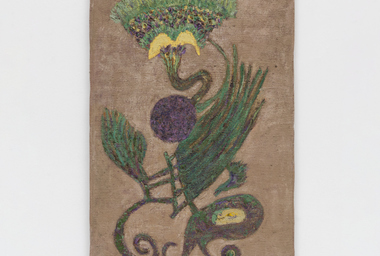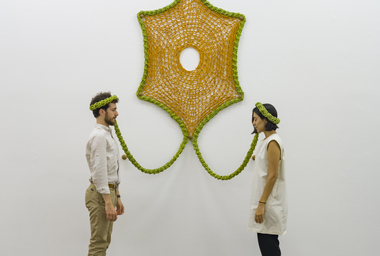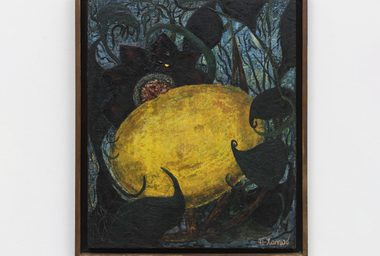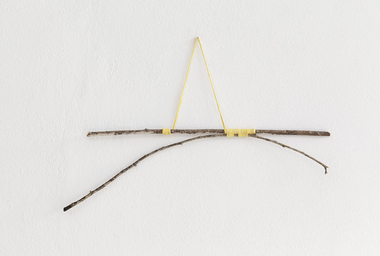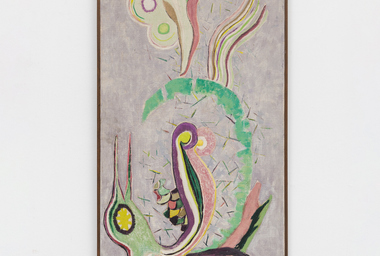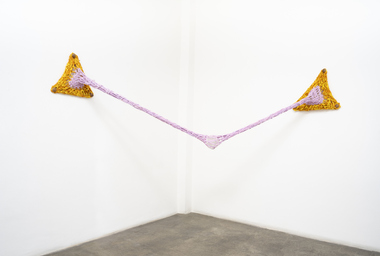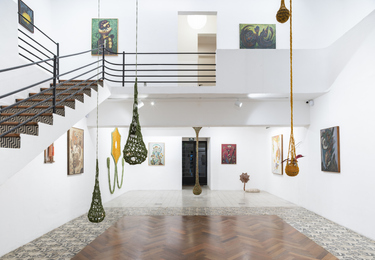
Ernesto Neto
Niobe Xandó
Niobe Xandó & Ernesto Neto
Jun 9 – Jul 30, 2022
Gomide&Co
Al. Ministro Rocha Azevedo 1052
Jardim Paulista, São Paulo – SP
Visiting hours
Mon-Fri: 10am — 7pm
Sat: 10am — 3pm
Opening
Jun 9, 6 pm–9 pm
Special project
Download
Gomide&Co and Fortes D’Aloia & Gabriel are pleased to present Niobe Xandó & Ernesto Neto. In the exhibition, fantastic flowers paintings by Niobe Xandó (1915-2010) are juxtaposed with the works in crochet and other organic materials by Ernesto Neto (1964). A critical essay by Julia de Souza accompanies the show.
The Splendor of the Forest
By Julia de Souza
More beautiful than these flowers
— but much more beautiful — that blossom
tormenting a thousand greens
more beautiful than these red ones
bursting the garden into flames,
where imprecise hands
punish wanting to harvest,
they are the never born,
they are those hidden flowers
in the subsurface of desire.
Olga Savary
— everything lives, dances and makes noise
Ruy Duarte de Carvalho
It is in the twilight that the prolific artist from São Paulo Niobe Xandó seems to have glimpsed her fantastic flowers: in the transition between day and night, when the colors of the world take on a suspicious and unruly aspect, like a musical piece that moves from a high to a low tone, impregnating the listener with an almost imperceptible discomfort. In this garden or forest that fades to darkness, the flowers are more than flowers: flower-creatures that appear to swallow themselves or to suffocate all the other elements in these weird landscapes. Often considered an intermediate phase in Xandó’s oeuvre, her fantastic flowers reveal an aesthetic intuition for what secretly goes on amidst the foliage — or brushstrokes. In Fantastic Flower VI, a bleak bluish bush surrounds a yellow egg as if about to devour it. In Fantastic Flower XXXI, a robust plant stands large against a purplish background. It is not easy to distinguish the different parts of the plant: the two round forms at the top look like flowers, whilst dark green stubbles evoke spiky leaves. At the bottom, a split oval shape introduces the notion of fertility, as if the flower had a womb. In fact, morphologically, flowers have both ovaries and eggs, which constitute its gynoecium — the group of female reproductive organs. The paintings that make up this phase in Niobe Xandó’s practice are a radical contemplation of the sexual nature of the structure and genesis of flowers.
Ernesto Neto’s unmistakable drops, which have been recurring in the artist’s practice since the 1990s, also suggest a uterine environment: their ends are a belly carrying elements of nature, such as bay leaves, spices, cotton, stones, vases with plants. A sort of reverse construction, these large, crocheted drops that hang from webs installed in the ceiling offer an inverted perspective, giving us — and the spiders — the destabilizing impression that the sky can also be the floor. Crochet, a crucial resource for the construction of these structures, allows the creation of pieces that constitute a zone of formal ambivalences: lightness and gravity, flexibility and tension, verticality and elongation. In addition, crochet is an ancient and traditionally female technique — once again we are faced with a gestational universe, which proposes another form of duration.
Two of his most recent works already express through their titles an anti-productive approach to time: Deslisa tempo, deslisa devagar [Slide Time, Slide Slowly] and Parabolando o tempo por aí [Curving Time Around], from 2021, are both made with string and sticks that resemble tools or instruments — slingshots, booby traps, bow and arrow. However, the objects in this series move away from any utilitarian role: if at first his compositions evoke instruments for measuring, hunting or flying, we soon notice both their fragility and the incompleteness, as well as the idle time proposed by the titles. It is not by chance that there is a spelling mistake in the word Deslisa [Slide], which should read Desliza: these objects produced by Neto resist the need to get it right or to hit the target by creating parabolas, allegories of a less voracious time.
In an interview where he gives an account of his immersive encounter with the Huni Kuin, an Amerindian people that live in the Brazilian state of Acre, Neto says: “They have a different relationship with time; they have time to wait! No one is in a hurry”. In Neto’s arrangements and objects, this temporality, which is closer to flux rather than calculations or intervals, is translated into attention to the mutable and transformational in nature (and the links that we can establish with it). In Gota fogo sobre água [Drop Fire on Water], a lit candle floating on water is nestled inside a green crocheted drop made with cotton thread. The interaction between water, fire and cotton (representing the earth) reaffirms the reciprocity between nature’s four elements: let us remember there must be air for fire to exist.
Niobe Xandó also penetrates this kingdom of indistinct limits. However, she seems concerned, above all, with the secret ferocity of plants, as if, by borrowing from the title of Clarice Lispector’s novel, she was “near to the wild heart”, where continuity exceeds any possibility of individuation. If some compositions resemble the verticality of flower arrangements in still-lifes (but always destabilizing the ideas of ornament and passivity), others seem to swallow themselves, merge together or configure a multiple, disordered gestation — for instance, in the case of Fantastic Flowers (Re-reading). In the book The Life of Plants, Italian philosopher Emanuele Coccia, reflects on the sexual reproduction of flowers, and argues that “in the flower, reproduction ceases to be the instrument of individual or specific narcissism to become an ecology of condensation and mixture”. This sense of continuity is also present in Xandó’s process. In an interview, the artist says: “I feel everything like one single thing: me, the canvas, the paint, the wild world that envelops us”.
In Flor-pássaro [Flower-Bird], this hybridity and the almost promiscuous indistinction between elements become even more radical: on a carmine background parts of a bird or a flower are scattered around. The petals can be mistaken for plumage; the sepals are also wings; the animal’s beak stands in for a floral ovary. In this sense, we can associate both Neto’s structures and Xandó’s compositions with the notion of biogenesis, a principle based on the idea that every living being arises from another living being.
If Xandó’s paintings tend towards a disorderly and strange configuration of nature, by approaching these vegetal creatures from a penetrating, sexual and approximated angle, Neto’s objects and structures have a ritual, almost allegorical dimension: the artist combines several symbolic and cosmogonic elements linked to indigenous or diasporic cultures — let us be reminded of the title Iaiá kui arã naia, which merges Afro-Brazilian and Amerindian words. In contrast, the presence of spices, as well as a way of triggering the pleasure of smell and making reference to the curative dimension of plants, also evokes the history of colonization and imperialism, given that such ingredients, before arriving here, were highly profitable commodities that triggered the European expeditions of the 15th and 16th centuries heading towards the East Indies. They are, therefore, seagoing species, which have traveled through deep time and space.
Neto places us before a forest of senses and knowledge, where the symbolic articulations of the elements suggest the possibility of another form of interacting with time, space, living beings and reproduction. In a sort of poem, the artist sums up the alternative mode of life that he practiced alongside the Huni Kuin:
Exchange as Transformation
contact area
the contact area is
a space of transformation
the contact transforms
the combination of sources of life
celebrating sexual reproduction
that has been intermixing us for centuries
[…]
the dream is concrete
it speaks of reality
it communicates through the night
when the spirits dance to show us
the way
Perhaps the compositions of Ernesto Neto and Niobe Xandó meet in the twilight of the forest that instigates them: in the case of Neto, shapes of the jungle hang in drops that are as light and permeable as they are robust and full of ancestral and symbolic ingredients, combining fall and suspension, duration and fragility; or take the form of useless utensils facing the fury of the time of productivity, inviting us to take a rest. In Xandó’s case, who has stated that “the violence of the world” is a “challenge”, forms are presented as inconstant, disorderly shadows, both floral and carnivorous: hybrid flowers that consume themselves, that challenge and rebel — camouflaged in the secret ecstasy of the fecund and voluminous night of the forest.
